Business Finance Report: Bright Lawns Ltd and BoatWater Plc
VerifiedAdded on 2023/01/18
|13
|3953
|57
Report
AI Summary
This business finance report comprehensively examines key financial concepts and their practical application. Part A focuses on understanding profit, cash flow, and the crucial differences between them, followed by an in-depth exploration of working capital components like accounts receivable, accounts payable, and inventory. The report then applies these concepts to the case of Bright Lawns Ltd, analyzing the company's financial position, including its profit, cash flow, and working capital challenges. It offers strategic recommendations for improving cash flow through better working capital management, such as handling accounts payables, managing inventory, implementing stringent policies for debtors, and evaluating debt levels. Part 2 shifts the focus to budgeting, discussing the purpose of budget preparation and contrasting traditional and alternative budgeting methods. The report analyzes the most appropriate budgeting method for BoatWater Plc, considering the advantages and disadvantages of each approach. The report provides insights into financial analysis, working capital, budgeting, and strategic recommendations for improving financial performance, making it a valuable resource for students studying business finance.
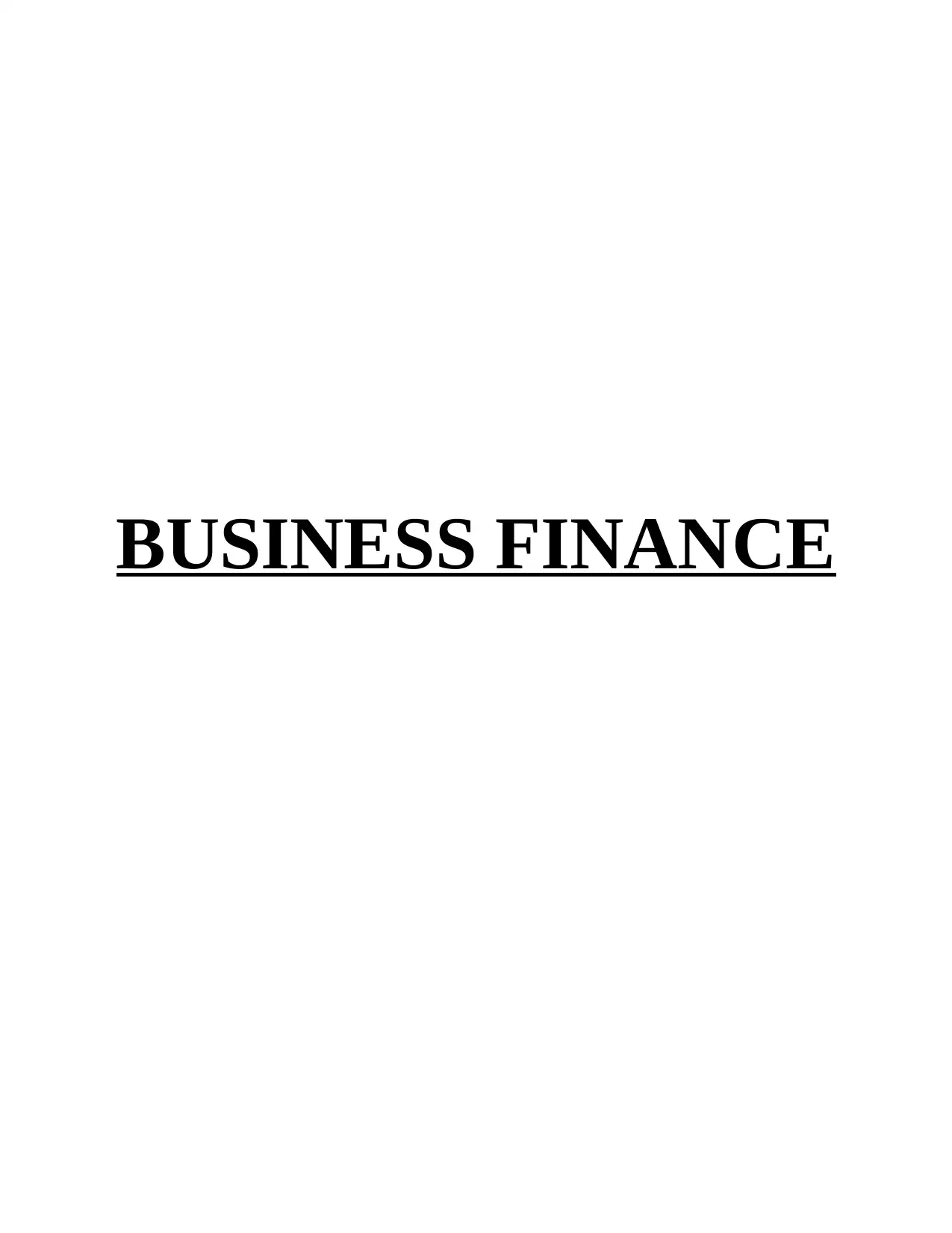
BUSINESS FINANCE
Paraphrase This Document
Need a fresh take? Get an instant paraphrase of this document with our AI Paraphraser
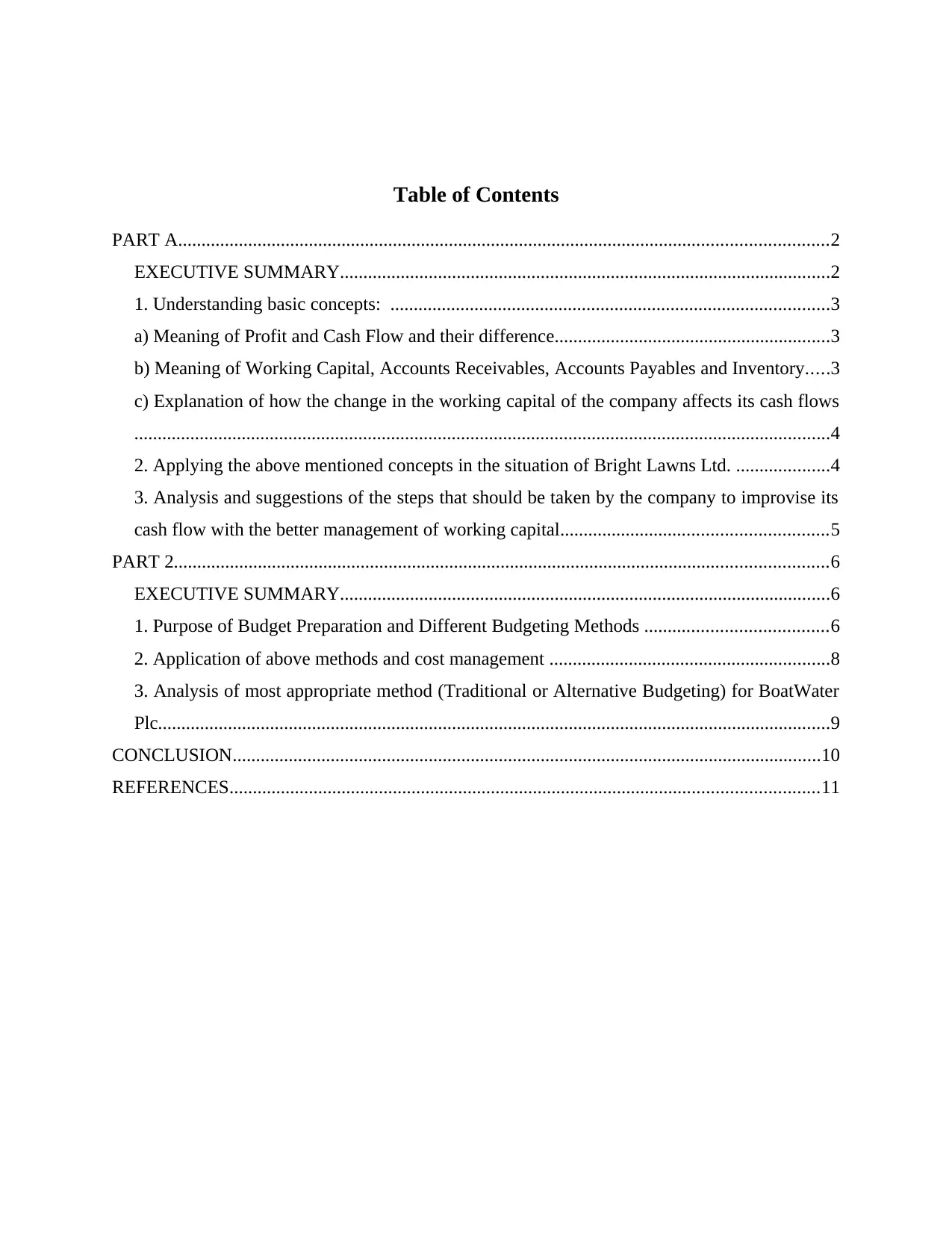
Table of Contents
PART A...........................................................................................................................................2
EXECUTIVE SUMMARY.........................................................................................................2
1. Understanding basic concepts: ..............................................................................................3
a) Meaning of Profit and Cash Flow and their difference...........................................................3
b) Meaning of Working Capital, Accounts Receivables, Accounts Payables and Inventory.....3
c) Explanation of how the change in the working capital of the company affects its cash flows
.....................................................................................................................................................4
2. Applying the above mentioned concepts in the situation of Bright Lawns Ltd. ....................4
3. Analysis and suggestions of the steps that should be taken by the company to improvise its
cash flow with the better management of working capital.........................................................5
PART 2............................................................................................................................................6
EXECUTIVE SUMMARY.........................................................................................................6
1. Purpose of Budget Preparation and Different Budgeting Methods .......................................6
2. Application of above methods and cost management ............................................................8
3. Analysis of most appropriate method (Traditional or Alternative Budgeting) for BoatWater
Plc................................................................................................................................................9
CONCLUSION..............................................................................................................................10
REFERENCES..............................................................................................................................11
PART A...........................................................................................................................................2
EXECUTIVE SUMMARY.........................................................................................................2
1. Understanding basic concepts: ..............................................................................................3
a) Meaning of Profit and Cash Flow and their difference...........................................................3
b) Meaning of Working Capital, Accounts Receivables, Accounts Payables and Inventory.....3
c) Explanation of how the change in the working capital of the company affects its cash flows
.....................................................................................................................................................4
2. Applying the above mentioned concepts in the situation of Bright Lawns Ltd. ....................4
3. Analysis and suggestions of the steps that should be taken by the company to improvise its
cash flow with the better management of working capital.........................................................5
PART 2............................................................................................................................................6
EXECUTIVE SUMMARY.........................................................................................................6
1. Purpose of Budget Preparation and Different Budgeting Methods .......................................6
2. Application of above methods and cost management ............................................................8
3. Analysis of most appropriate method (Traditional or Alternative Budgeting) for BoatWater
Plc................................................................................................................................................9
CONCLUSION..............................................................................................................................10
REFERENCES..............................................................................................................................11
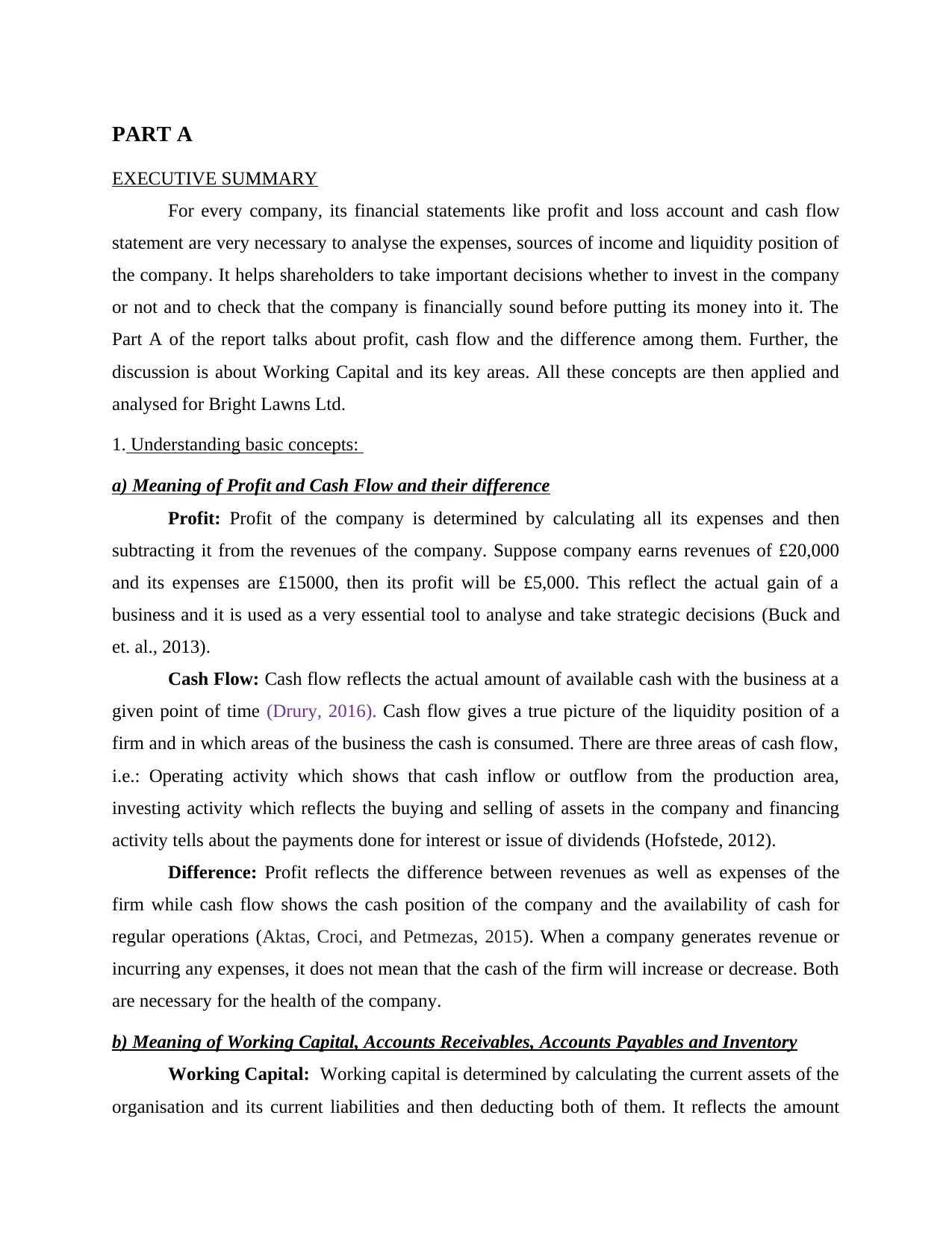
PART A
EXECUTIVE SUMMARY
For every company, its financial statements like profit and loss account and cash flow
statement are very necessary to analyse the expenses, sources of income and liquidity position of
the company. It helps shareholders to take important decisions whether to invest in the company
or not and to check that the company is financially sound before putting its money into it. The
Part A of the report talks about profit, cash flow and the difference among them. Further, the
discussion is about Working Capital and its key areas. All these concepts are then applied and
analysed for Bright Lawns Ltd.
1. Understanding basic concepts:
a) Meaning of Profit and Cash Flow and their difference
Profit: Profit of the company is determined by calculating all its expenses and then
subtracting it from the revenues of the company. Suppose company earns revenues of £20,000
and its expenses are £15000, then its profit will be £5,000. This reflect the actual gain of a
business and it is used as a very essential tool to analyse and take strategic decisions (Buck and
et. al., 2013).
Cash Flow: Cash flow reflects the actual amount of available cash with the business at a
given point of time (Drury, 2016). Cash flow gives a true picture of the liquidity position of a
firm and in which areas of the business the cash is consumed. There are three areas of cash flow,
i.e.: Operating activity which shows that cash inflow or outflow from the production area,
investing activity which reflects the buying and selling of assets in the company and financing
activity tells about the payments done for interest or issue of dividends (Hofstede, 2012).
Difference: Profit reflects the difference between revenues as well as expenses of the
firm while cash flow shows the cash position of the company and the availability of cash for
regular operations (Aktas, Croci, and Petmezas, 2015). When a company generates revenue or
incurring any expenses, it does not mean that the cash of the firm will increase or decrease. Both
are necessary for the health of the company.
b) Meaning of Working Capital, Accounts Receivables, Accounts Payables and Inventory
Working Capital: Working capital is determined by calculating the current assets of the
organisation and its current liabilities and then deducting both of them. It reflects the amount
EXECUTIVE SUMMARY
For every company, its financial statements like profit and loss account and cash flow
statement are very necessary to analyse the expenses, sources of income and liquidity position of
the company. It helps shareholders to take important decisions whether to invest in the company
or not and to check that the company is financially sound before putting its money into it. The
Part A of the report talks about profit, cash flow and the difference among them. Further, the
discussion is about Working Capital and its key areas. All these concepts are then applied and
analysed for Bright Lawns Ltd.
1. Understanding basic concepts:
a) Meaning of Profit and Cash Flow and their difference
Profit: Profit of the company is determined by calculating all its expenses and then
subtracting it from the revenues of the company. Suppose company earns revenues of £20,000
and its expenses are £15000, then its profit will be £5,000. This reflect the actual gain of a
business and it is used as a very essential tool to analyse and take strategic decisions (Buck and
et. al., 2013).
Cash Flow: Cash flow reflects the actual amount of available cash with the business at a
given point of time (Drury, 2016). Cash flow gives a true picture of the liquidity position of a
firm and in which areas of the business the cash is consumed. There are three areas of cash flow,
i.e.: Operating activity which shows that cash inflow or outflow from the production area,
investing activity which reflects the buying and selling of assets in the company and financing
activity tells about the payments done for interest or issue of dividends (Hofstede, 2012).
Difference: Profit reflects the difference between revenues as well as expenses of the
firm while cash flow shows the cash position of the company and the availability of cash for
regular operations (Aktas, Croci, and Petmezas, 2015). When a company generates revenue or
incurring any expenses, it does not mean that the cash of the firm will increase or decrease. Both
are necessary for the health of the company.
b) Meaning of Working Capital, Accounts Receivables, Accounts Payables and Inventory
Working Capital: Working capital is determined by calculating the current assets of the
organisation and its current liabilities and then deducting both of them. It reflects the amount
⊘ This is a preview!⊘
Do you want full access?
Subscribe today to unlock all pages.

Trusted by 1+ million students worldwide
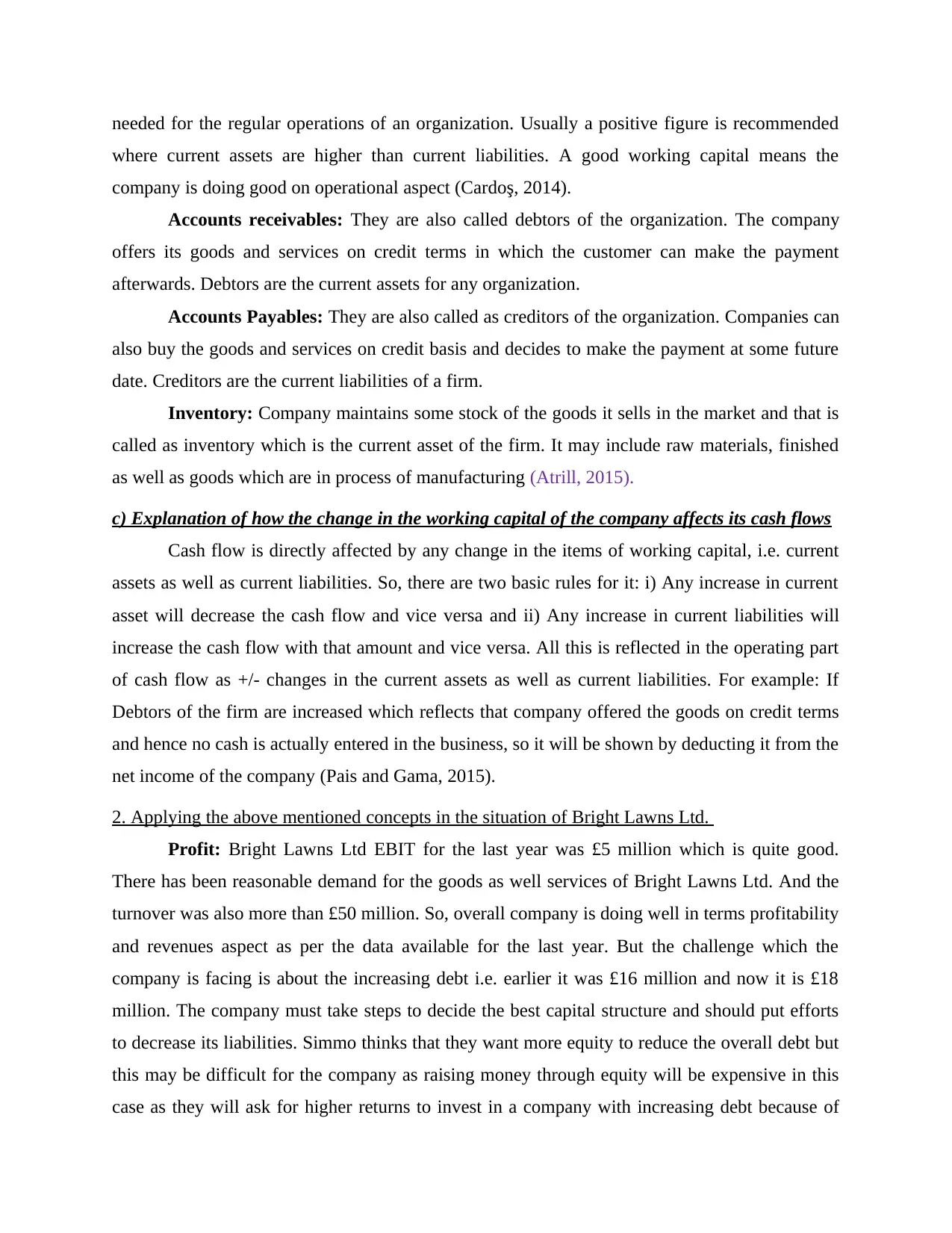
needed for the regular operations of an organization. Usually a positive figure is recommended
where current assets are higher than current liabilities. A good working capital means the
company is doing good on operational aspect (Cardoş, 2014).
Accounts receivables: They are also called debtors of the organization. The company
offers its goods and services on credit terms in which the customer can make the payment
afterwards. Debtors are the current assets for any organization.
Accounts Payables: They are also called as creditors of the organization. Companies can
also buy the goods and services on credit basis and decides to make the payment at some future
date. Creditors are the current liabilities of a firm.
Inventory: Company maintains some stock of the goods it sells in the market and that is
called as inventory which is the current asset of the firm. It may include raw materials, finished
as well as goods which are in process of manufacturing (Atrill, 2015).
c) Explanation of how the change in the working capital of the company affects its cash flows
Cash flow is directly affected by any change in the items of working capital, i.e. current
assets as well as current liabilities. So, there are two basic rules for it: i) Any increase in current
asset will decrease the cash flow and vice versa and ii) Any increase in current liabilities will
increase the cash flow with that amount and vice versa. All this is reflected in the operating part
of cash flow as +/- changes in the current assets as well as current liabilities. For example: If
Debtors of the firm are increased which reflects that company offered the goods on credit terms
and hence no cash is actually entered in the business, so it will be shown by deducting it from the
net income of the company (Pais and Gama, 2015).
2. Applying the above mentioned concepts in the situation of Bright Lawns Ltd.
Profit: Bright Lawns Ltd EBIT for the last year was £5 million which is quite good.
There has been reasonable demand for the goods as well services of Bright Lawns Ltd. And the
turnover was also more than £50 million. So, overall company is doing well in terms profitability
and revenues aspect as per the data available for the last year. But the challenge which the
company is facing is about the increasing debt i.e. earlier it was £16 million and now it is £18
million. The company must take steps to decide the best capital structure and should put efforts
to decrease its liabilities. Simmo thinks that they want more equity to reduce the overall debt but
this may be difficult for the company as raising money through equity will be expensive in this
case as they will ask for higher returns to invest in a company with increasing debt because of
where current assets are higher than current liabilities. A good working capital means the
company is doing good on operational aspect (Cardoş, 2014).
Accounts receivables: They are also called debtors of the organization. The company
offers its goods and services on credit terms in which the customer can make the payment
afterwards. Debtors are the current assets for any organization.
Accounts Payables: They are also called as creditors of the organization. Companies can
also buy the goods and services on credit basis and decides to make the payment at some future
date. Creditors are the current liabilities of a firm.
Inventory: Company maintains some stock of the goods it sells in the market and that is
called as inventory which is the current asset of the firm. It may include raw materials, finished
as well as goods which are in process of manufacturing (Atrill, 2015).
c) Explanation of how the change in the working capital of the company affects its cash flows
Cash flow is directly affected by any change in the items of working capital, i.e. current
assets as well as current liabilities. So, there are two basic rules for it: i) Any increase in current
asset will decrease the cash flow and vice versa and ii) Any increase in current liabilities will
increase the cash flow with that amount and vice versa. All this is reflected in the operating part
of cash flow as +/- changes in the current assets as well as current liabilities. For example: If
Debtors of the firm are increased which reflects that company offered the goods on credit terms
and hence no cash is actually entered in the business, so it will be shown by deducting it from the
net income of the company (Pais and Gama, 2015).
2. Applying the above mentioned concepts in the situation of Bright Lawns Ltd.
Profit: Bright Lawns Ltd EBIT for the last year was £5 million which is quite good.
There has been reasonable demand for the goods as well services of Bright Lawns Ltd. And the
turnover was also more than £50 million. So, overall company is doing well in terms profitability
and revenues aspect as per the data available for the last year. But the challenge which the
company is facing is about the increasing debt i.e. earlier it was £16 million and now it is £18
million. The company must take steps to decide the best capital structure and should put efforts
to decrease its liabilities. Simmo thinks that they want more equity to reduce the overall debt but
this may be difficult for the company as raising money through equity will be expensive in this
case as they will ask for higher returns to invest in a company with increasing debt because of
Paraphrase This Document
Need a fresh take? Get an instant paraphrase of this document with our AI Paraphraser
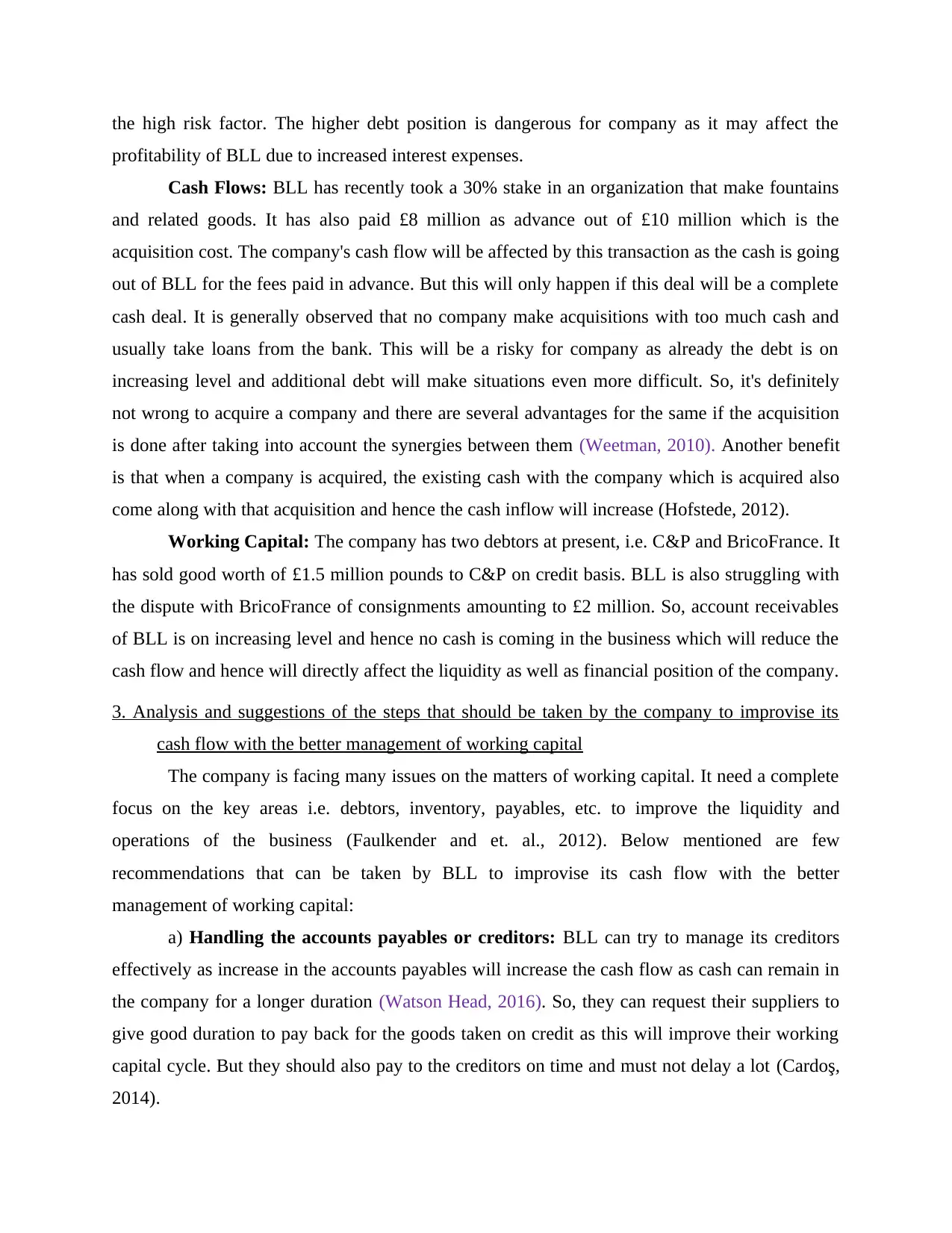
the high risk factor. The higher debt position is dangerous for company as it may affect the
profitability of BLL due to increased interest expenses.
Cash Flows: BLL has recently took a 30% stake in an organization that make fountains
and related goods. It has also paid £8 million as advance out of £10 million which is the
acquisition cost. The company's cash flow will be affected by this transaction as the cash is going
out of BLL for the fees paid in advance. But this will only happen if this deal will be a complete
cash deal. It is generally observed that no company make acquisitions with too much cash and
usually take loans from the bank. This will be a risky for company as already the debt is on
increasing level and additional debt will make situations even more difficult. So, it's definitely
not wrong to acquire a company and there are several advantages for the same if the acquisition
is done after taking into account the synergies between them (Weetman, 2010). Another benefit
is that when a company is acquired, the existing cash with the company which is acquired also
come along with that acquisition and hence the cash inflow will increase (Hofstede, 2012).
Working Capital: The company has two debtors at present, i.e. C&P and BricoFrance. It
has sold good worth of £1.5 million pounds to C&P on credit basis. BLL is also struggling with
the dispute with BricoFrance of consignments amounting to £2 million. So, account receivables
of BLL is on increasing level and hence no cash is coming in the business which will reduce the
cash flow and hence will directly affect the liquidity as well as financial position of the company.
3. Analysis and suggestions of the steps that should be taken by the company to improvise its
cash flow with the better management of working capital
The company is facing many issues on the matters of working capital. It need a complete
focus on the key areas i.e. debtors, inventory, payables, etc. to improve the liquidity and
operations of the business (Faulkender and et. al., 2012). Below mentioned are few
recommendations that can be taken by BLL to improvise its cash flow with the better
management of working capital:
a) Handling the accounts payables or creditors: BLL can try to manage its creditors
effectively as increase in the accounts payables will increase the cash flow as cash can remain in
the company for a longer duration (Watson Head, 2016). So, they can request their suppliers to
give good duration to pay back for the goods taken on credit as this will improve their working
capital cycle. But they should also pay to the creditors on time and must not delay a lot (Cardoş,
2014).
profitability of BLL due to increased interest expenses.
Cash Flows: BLL has recently took a 30% stake in an organization that make fountains
and related goods. It has also paid £8 million as advance out of £10 million which is the
acquisition cost. The company's cash flow will be affected by this transaction as the cash is going
out of BLL for the fees paid in advance. But this will only happen if this deal will be a complete
cash deal. It is generally observed that no company make acquisitions with too much cash and
usually take loans from the bank. This will be a risky for company as already the debt is on
increasing level and additional debt will make situations even more difficult. So, it's definitely
not wrong to acquire a company and there are several advantages for the same if the acquisition
is done after taking into account the synergies between them (Weetman, 2010). Another benefit
is that when a company is acquired, the existing cash with the company which is acquired also
come along with that acquisition and hence the cash inflow will increase (Hofstede, 2012).
Working Capital: The company has two debtors at present, i.e. C&P and BricoFrance. It
has sold good worth of £1.5 million pounds to C&P on credit basis. BLL is also struggling with
the dispute with BricoFrance of consignments amounting to £2 million. So, account receivables
of BLL is on increasing level and hence no cash is coming in the business which will reduce the
cash flow and hence will directly affect the liquidity as well as financial position of the company.
3. Analysis and suggestions of the steps that should be taken by the company to improvise its
cash flow with the better management of working capital
The company is facing many issues on the matters of working capital. It need a complete
focus on the key areas i.e. debtors, inventory, payables, etc. to improve the liquidity and
operations of the business (Faulkender and et. al., 2012). Below mentioned are few
recommendations that can be taken by BLL to improvise its cash flow with the better
management of working capital:
a) Handling the accounts payables or creditors: BLL can try to manage its creditors
effectively as increase in the accounts payables will increase the cash flow as cash can remain in
the company for a longer duration (Watson Head, 2016). So, they can request their suppliers to
give good duration to pay back for the goods taken on credit as this will improve their working
capital cycle. But they should also pay to the creditors on time and must not delay a lot (Cardoş,
2014).
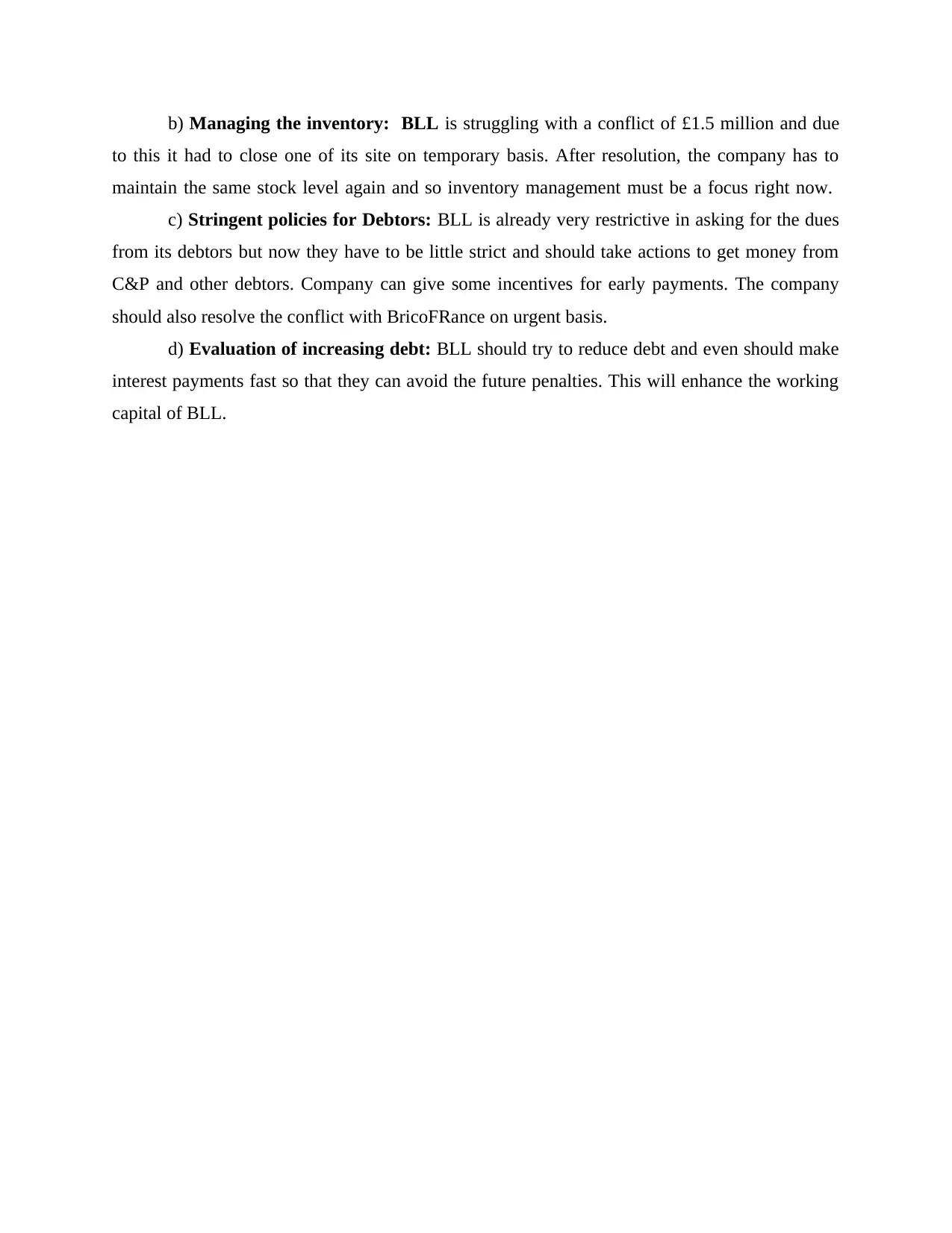
b) Managing the inventory: BLL is struggling with a conflict of £1.5 million and due
to this it had to close one of its site on temporary basis. After resolution, the company has to
maintain the same stock level again and so inventory management must be a focus right now.
c) Stringent policies for Debtors: BLL is already very restrictive in asking for the dues
from its debtors but now they have to be little strict and should take actions to get money from
C&P and other debtors. Company can give some incentives for early payments. The company
should also resolve the conflict with BricoFRance on urgent basis.
d) Evaluation of increasing debt: BLL should try to reduce debt and even should make
interest payments fast so that they can avoid the future penalties. This will enhance the working
capital of BLL.
to this it had to close one of its site on temporary basis. After resolution, the company has to
maintain the same stock level again and so inventory management must be a focus right now.
c) Stringent policies for Debtors: BLL is already very restrictive in asking for the dues
from its debtors but now they have to be little strict and should take actions to get money from
C&P and other debtors. Company can give some incentives for early payments. The company
should also resolve the conflict with BricoFRance on urgent basis.
d) Evaluation of increasing debt: BLL should try to reduce debt and even should make
interest payments fast so that they can avoid the future penalties. This will enhance the working
capital of BLL.
⊘ This is a preview!⊘
Do you want full access?
Subscribe today to unlock all pages.

Trusted by 1+ million students worldwide
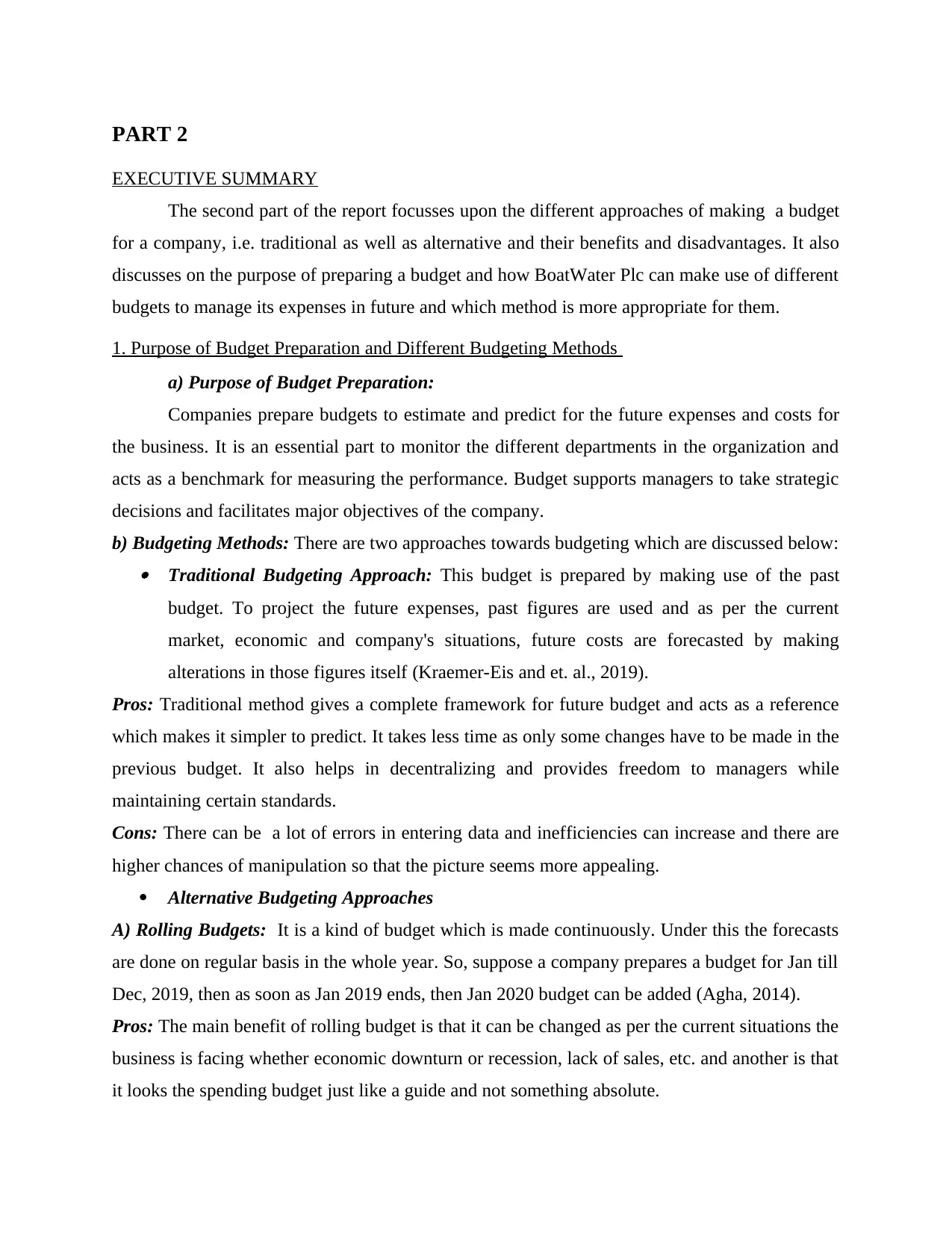
PART 2
EXECUTIVE SUMMARY
The second part of the report focusses upon the different approaches of making a budget
for a company, i.e. traditional as well as alternative and their benefits and disadvantages. It also
discusses on the purpose of preparing a budget and how BoatWater Plc can make use of different
budgets to manage its expenses in future and which method is more appropriate for them.
1. Purpose of Budget Preparation and Different Budgeting Methods
a) Purpose of Budget Preparation:
Companies prepare budgets to estimate and predict for the future expenses and costs for
the business. It is an essential part to monitor the different departments in the organization and
acts as a benchmark for measuring the performance. Budget supports managers to take strategic
decisions and facilitates major objectives of the company.
b) Budgeting Methods: There are two approaches towards budgeting which are discussed below: Traditional Budgeting Approach: This budget is prepared by making use of the past
budget. To project the future expenses, past figures are used and as per the current
market, economic and company's situations, future costs are forecasted by making
alterations in those figures itself (Kraemer-Eis and et. al., 2019).
Pros: Traditional method gives a complete framework for future budget and acts as a reference
which makes it simpler to predict. It takes less time as only some changes have to be made in the
previous budget. It also helps in decentralizing and provides freedom to managers while
maintaining certain standards.
Cons: There can be a lot of errors in entering data and inefficiencies can increase and there are
higher chances of manipulation so that the picture seems more appealing.
Alternative Budgeting Approaches
A) Rolling Budgets: It is a kind of budget which is made continuously. Under this the forecasts
are done on regular basis in the whole year. So, suppose a company prepares a budget for Jan till
Dec, 2019, then as soon as Jan 2019 ends, then Jan 2020 budget can be added (Agha, 2014).
Pros: The main benefit of rolling budget is that it can be changed as per the current situations the
business is facing whether economic downturn or recession, lack of sales, etc. and another is that
it looks the spending budget just like a guide and not something absolute.
EXECUTIVE SUMMARY
The second part of the report focusses upon the different approaches of making a budget
for a company, i.e. traditional as well as alternative and their benefits and disadvantages. It also
discusses on the purpose of preparing a budget and how BoatWater Plc can make use of different
budgets to manage its expenses in future and which method is more appropriate for them.
1. Purpose of Budget Preparation and Different Budgeting Methods
a) Purpose of Budget Preparation:
Companies prepare budgets to estimate and predict for the future expenses and costs for
the business. It is an essential part to monitor the different departments in the organization and
acts as a benchmark for measuring the performance. Budget supports managers to take strategic
decisions and facilitates major objectives of the company.
b) Budgeting Methods: There are two approaches towards budgeting which are discussed below: Traditional Budgeting Approach: This budget is prepared by making use of the past
budget. To project the future expenses, past figures are used and as per the current
market, economic and company's situations, future costs are forecasted by making
alterations in those figures itself (Kraemer-Eis and et. al., 2019).
Pros: Traditional method gives a complete framework for future budget and acts as a reference
which makes it simpler to predict. It takes less time as only some changes have to be made in the
previous budget. It also helps in decentralizing and provides freedom to managers while
maintaining certain standards.
Cons: There can be a lot of errors in entering data and inefficiencies can increase and there are
higher chances of manipulation so that the picture seems more appealing.
Alternative Budgeting Approaches
A) Rolling Budgets: It is a kind of budget which is made continuously. Under this the forecasts
are done on regular basis in the whole year. So, suppose a company prepares a budget for Jan till
Dec, 2019, then as soon as Jan 2019 ends, then Jan 2020 budget can be added (Agha, 2014).
Pros: The main benefit of rolling budget is that it can be changed as per the current situations the
business is facing whether economic downturn or recession, lack of sales, etc. and another is that
it looks the spending budget just like a guide and not something absolute.
Paraphrase This Document
Need a fresh take? Get an instant paraphrase of this document with our AI Paraphraser
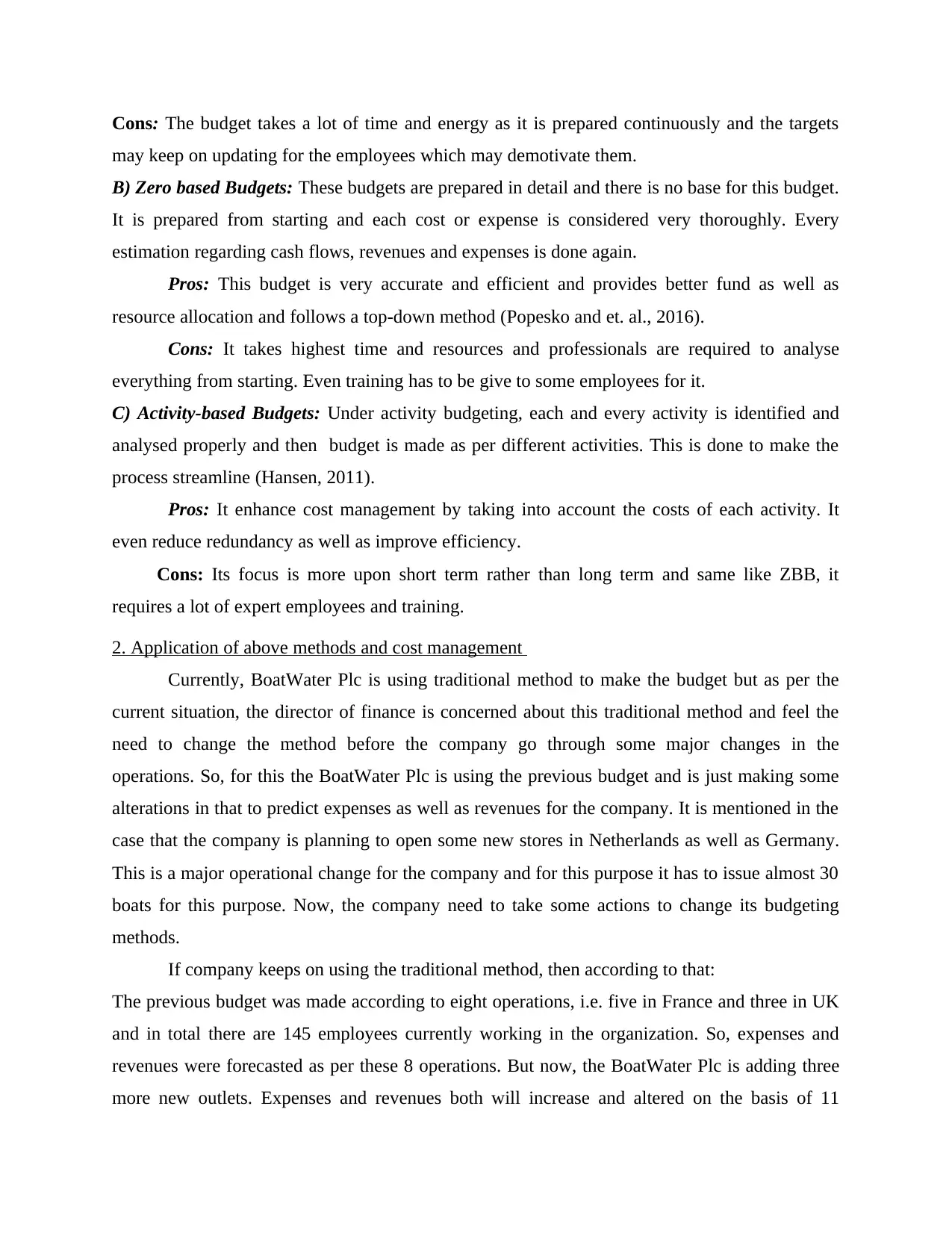
Cons: The budget takes a lot of time and energy as it is prepared continuously and the targets
may keep on updating for the employees which may demotivate them.
B) Zero based Budgets: These budgets are prepared in detail and there is no base for this budget.
It is prepared from starting and each cost or expense is considered very thoroughly. Every
estimation regarding cash flows, revenues and expenses is done again.
Pros: This budget is very accurate and efficient and provides better fund as well as
resource allocation and follows a top-down method (Popesko and et. al., 2016).
Cons: It takes highest time and resources and professionals are required to analyse
everything from starting. Even training has to be give to some employees for it.
C) Activity-based Budgets: Under activity budgeting, each and every activity is identified and
analysed properly and then budget is made as per different activities. This is done to make the
process streamline (Hansen, 2011).
Pros: It enhance cost management by taking into account the costs of each activity. It
even reduce redundancy as well as improve efficiency.
Cons: Its focus is more upon short term rather than long term and same like ZBB, it
requires a lot of expert employees and training.
2. Application of above methods and cost management
Currently, BoatWater Plc is using traditional method to make the budget but as per the
current situation, the director of finance is concerned about this traditional method and feel the
need to change the method before the company go through some major changes in the
operations. So, for this the BoatWater Plc is using the previous budget and is just making some
alterations in that to predict expenses as well as revenues for the company. It is mentioned in the
case that the company is planning to open some new stores in Netherlands as well as Germany.
This is a major operational change for the company and for this purpose it has to issue almost 30
boats for this purpose. Now, the company need to take some actions to change its budgeting
methods.
If company keeps on using the traditional method, then according to that:
The previous budget was made according to eight operations, i.e. five in France and three in UK
and in total there are 145 employees currently working in the organization. So, expenses and
revenues were forecasted as per these 8 operations. But now, the BoatWater Plc is adding three
more new outlets. Expenses and revenues both will increase and altered on the basis of 11
may keep on updating for the employees which may demotivate them.
B) Zero based Budgets: These budgets are prepared in detail and there is no base for this budget.
It is prepared from starting and each cost or expense is considered very thoroughly. Every
estimation regarding cash flows, revenues and expenses is done again.
Pros: This budget is very accurate and efficient and provides better fund as well as
resource allocation and follows a top-down method (Popesko and et. al., 2016).
Cons: It takes highest time and resources and professionals are required to analyse
everything from starting. Even training has to be give to some employees for it.
C) Activity-based Budgets: Under activity budgeting, each and every activity is identified and
analysed properly and then budget is made as per different activities. This is done to make the
process streamline (Hansen, 2011).
Pros: It enhance cost management by taking into account the costs of each activity. It
even reduce redundancy as well as improve efficiency.
Cons: Its focus is more upon short term rather than long term and same like ZBB, it
requires a lot of expert employees and training.
2. Application of above methods and cost management
Currently, BoatWater Plc is using traditional method to make the budget but as per the
current situation, the director of finance is concerned about this traditional method and feel the
need to change the method before the company go through some major changes in the
operations. So, for this the BoatWater Plc is using the previous budget and is just making some
alterations in that to predict expenses as well as revenues for the company. It is mentioned in the
case that the company is planning to open some new stores in Netherlands as well as Germany.
This is a major operational change for the company and for this purpose it has to issue almost 30
boats for this purpose. Now, the company need to take some actions to change its budgeting
methods.
If company keeps on using the traditional method, then according to that:
The previous budget was made according to eight operations, i.e. five in France and three in UK
and in total there are 145 employees currently working in the organization. So, expenses and
revenues were forecasted as per these 8 operations. But now, the BoatWater Plc is adding three
more new outlets. Expenses and revenues both will increase and altered on the basis of 11
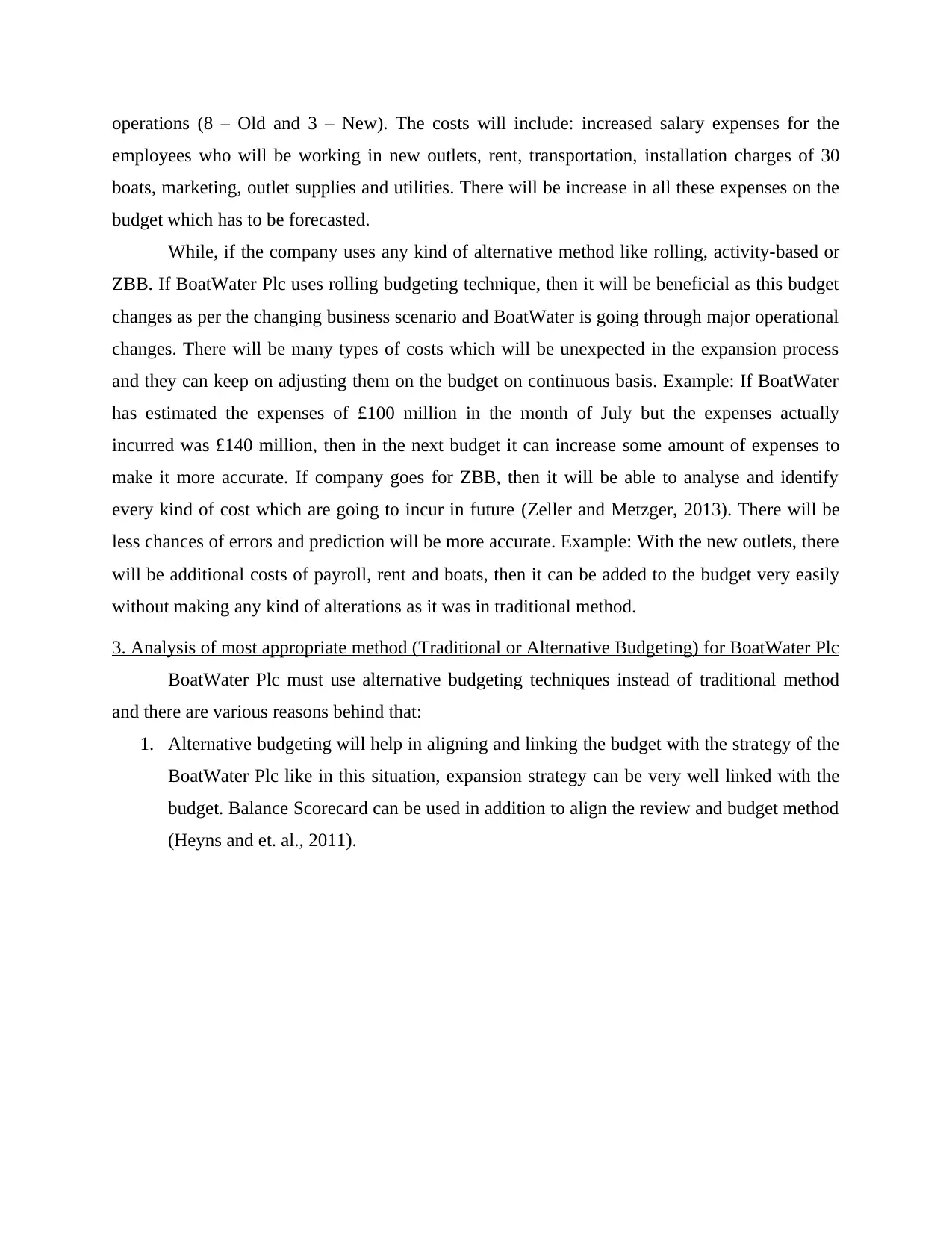
operations (8 – Old and 3 – New). The costs will include: increased salary expenses for the
employees who will be working in new outlets, rent, transportation, installation charges of 30
boats, marketing, outlet supplies and utilities. There will be increase in all these expenses on the
budget which has to be forecasted.
While, if the company uses any kind of alternative method like rolling, activity-based or
ZBB. If BoatWater Plc uses rolling budgeting technique, then it will be beneficial as this budget
changes as per the changing business scenario and BoatWater is going through major operational
changes. There will be many types of costs which will be unexpected in the expansion process
and they can keep on adjusting them on the budget on continuous basis. Example: If BoatWater
has estimated the expenses of £100 million in the month of July but the expenses actually
incurred was £140 million, then in the next budget it can increase some amount of expenses to
make it more accurate. If company goes for ZBB, then it will be able to analyse and identify
every kind of cost which are going to incur in future (Zeller and Metzger, 2013). There will be
less chances of errors and prediction will be more accurate. Example: With the new outlets, there
will be additional costs of payroll, rent and boats, then it can be added to the budget very easily
without making any kind of alterations as it was in traditional method.
3. Analysis of most appropriate method (Traditional or Alternative Budgeting) for BoatWater Plc
BoatWater Plc must use alternative budgeting techniques instead of traditional method
and there are various reasons behind that:
1. Alternative budgeting will help in aligning and linking the budget with the strategy of the
BoatWater Plc like in this situation, expansion strategy can be very well linked with the
budget. Balance Scorecard can be used in addition to align the review and budget method
(Heyns and et. al., 2011).
employees who will be working in new outlets, rent, transportation, installation charges of 30
boats, marketing, outlet supplies and utilities. There will be increase in all these expenses on the
budget which has to be forecasted.
While, if the company uses any kind of alternative method like rolling, activity-based or
ZBB. If BoatWater Plc uses rolling budgeting technique, then it will be beneficial as this budget
changes as per the changing business scenario and BoatWater is going through major operational
changes. There will be many types of costs which will be unexpected in the expansion process
and they can keep on adjusting them on the budget on continuous basis. Example: If BoatWater
has estimated the expenses of £100 million in the month of July but the expenses actually
incurred was £140 million, then in the next budget it can increase some amount of expenses to
make it more accurate. If company goes for ZBB, then it will be able to analyse and identify
every kind of cost which are going to incur in future (Zeller and Metzger, 2013). There will be
less chances of errors and prediction will be more accurate. Example: With the new outlets, there
will be additional costs of payroll, rent and boats, then it can be added to the budget very easily
without making any kind of alterations as it was in traditional method.
3. Analysis of most appropriate method (Traditional or Alternative Budgeting) for BoatWater Plc
BoatWater Plc must use alternative budgeting techniques instead of traditional method
and there are various reasons behind that:
1. Alternative budgeting will help in aligning and linking the budget with the strategy of the
BoatWater Plc like in this situation, expansion strategy can be very well linked with the
budget. Balance Scorecard can be used in addition to align the review and budget method
(Heyns and et. al., 2011).
⊘ This is a preview!⊘
Do you want full access?
Subscribe today to unlock all pages.

Trusted by 1+ million students worldwide
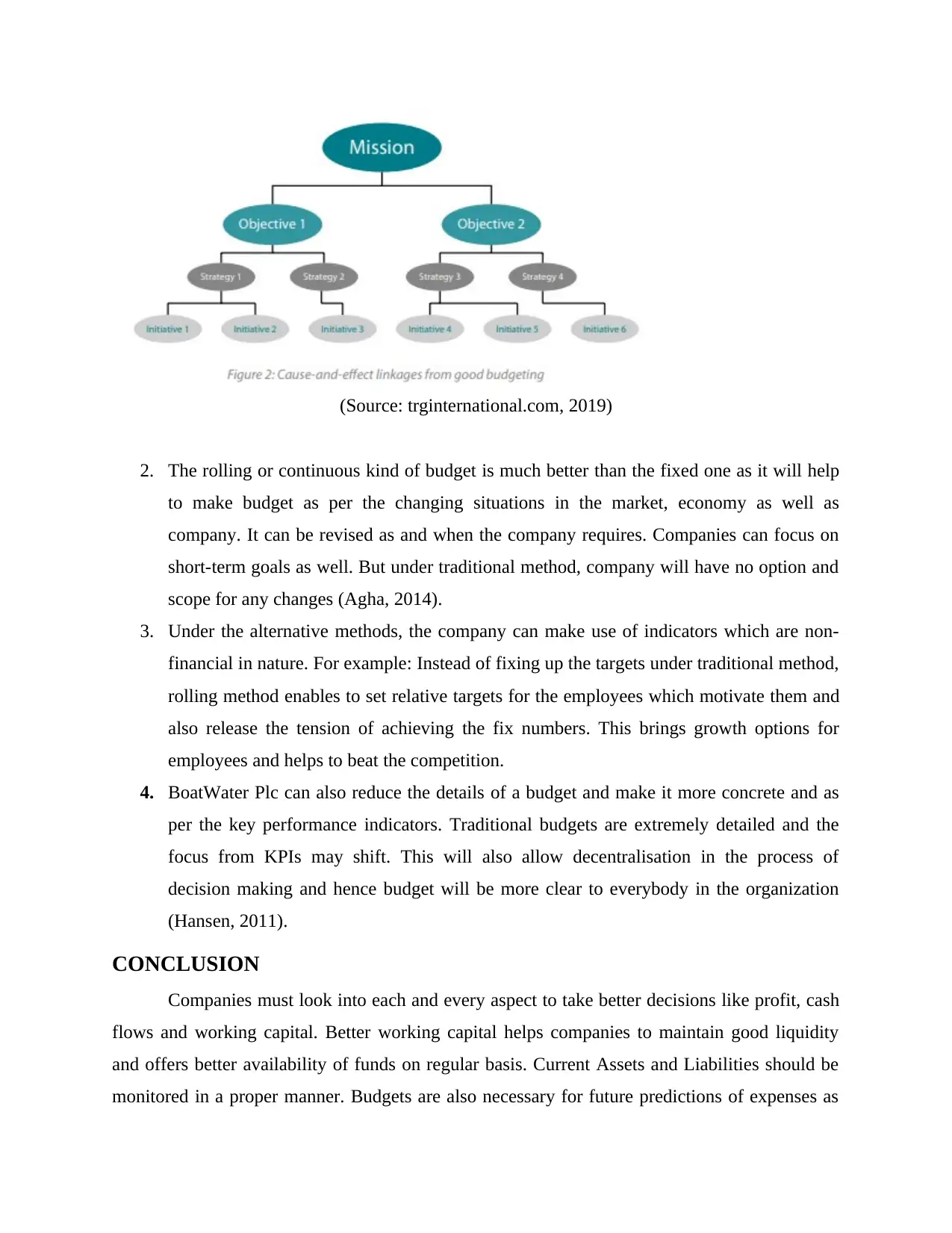
(Source: trginternational.com, 2019)
2. The rolling or continuous kind of budget is much better than the fixed one as it will help
to make budget as per the changing situations in the market, economy as well as
company. It can be revised as and when the company requires. Companies can focus on
short-term goals as well. But under traditional method, company will have no option and
scope for any changes (Agha, 2014).
3. Under the alternative methods, the company can make use of indicators which are non-
financial in nature. For example: Instead of fixing up the targets under traditional method,
rolling method enables to set relative targets for the employees which motivate them and
also release the tension of achieving the fix numbers. This brings growth options for
employees and helps to beat the competition.
4. BoatWater Plc can also reduce the details of a budget and make it more concrete and as
per the key performance indicators. Traditional budgets are extremely detailed and the
focus from KPIs may shift. This will also allow decentralisation in the process of
decision making and hence budget will be more clear to everybody in the organization
(Hansen, 2011).
CONCLUSION
Companies must look into each and every aspect to take better decisions like profit, cash
flows and working capital. Better working capital helps companies to maintain good liquidity
and offers better availability of funds on regular basis. Current Assets and Liabilities should be
monitored in a proper manner. Budgets are also necessary for future predictions of expenses as
2. The rolling or continuous kind of budget is much better than the fixed one as it will help
to make budget as per the changing situations in the market, economy as well as
company. It can be revised as and when the company requires. Companies can focus on
short-term goals as well. But under traditional method, company will have no option and
scope for any changes (Agha, 2014).
3. Under the alternative methods, the company can make use of indicators which are non-
financial in nature. For example: Instead of fixing up the targets under traditional method,
rolling method enables to set relative targets for the employees which motivate them and
also release the tension of achieving the fix numbers. This brings growth options for
employees and helps to beat the competition.
4. BoatWater Plc can also reduce the details of a budget and make it more concrete and as
per the key performance indicators. Traditional budgets are extremely detailed and the
focus from KPIs may shift. This will also allow decentralisation in the process of
decision making and hence budget will be more clear to everybody in the organization
(Hansen, 2011).
CONCLUSION
Companies must look into each and every aspect to take better decisions like profit, cash
flows and working capital. Better working capital helps companies to maintain good liquidity
and offers better availability of funds on regular basis. Current Assets and Liabilities should be
monitored in a proper manner. Budgets are also necessary for future predictions of expenses as
Paraphrase This Document
Need a fresh take? Get an instant paraphrase of this document with our AI Paraphraser
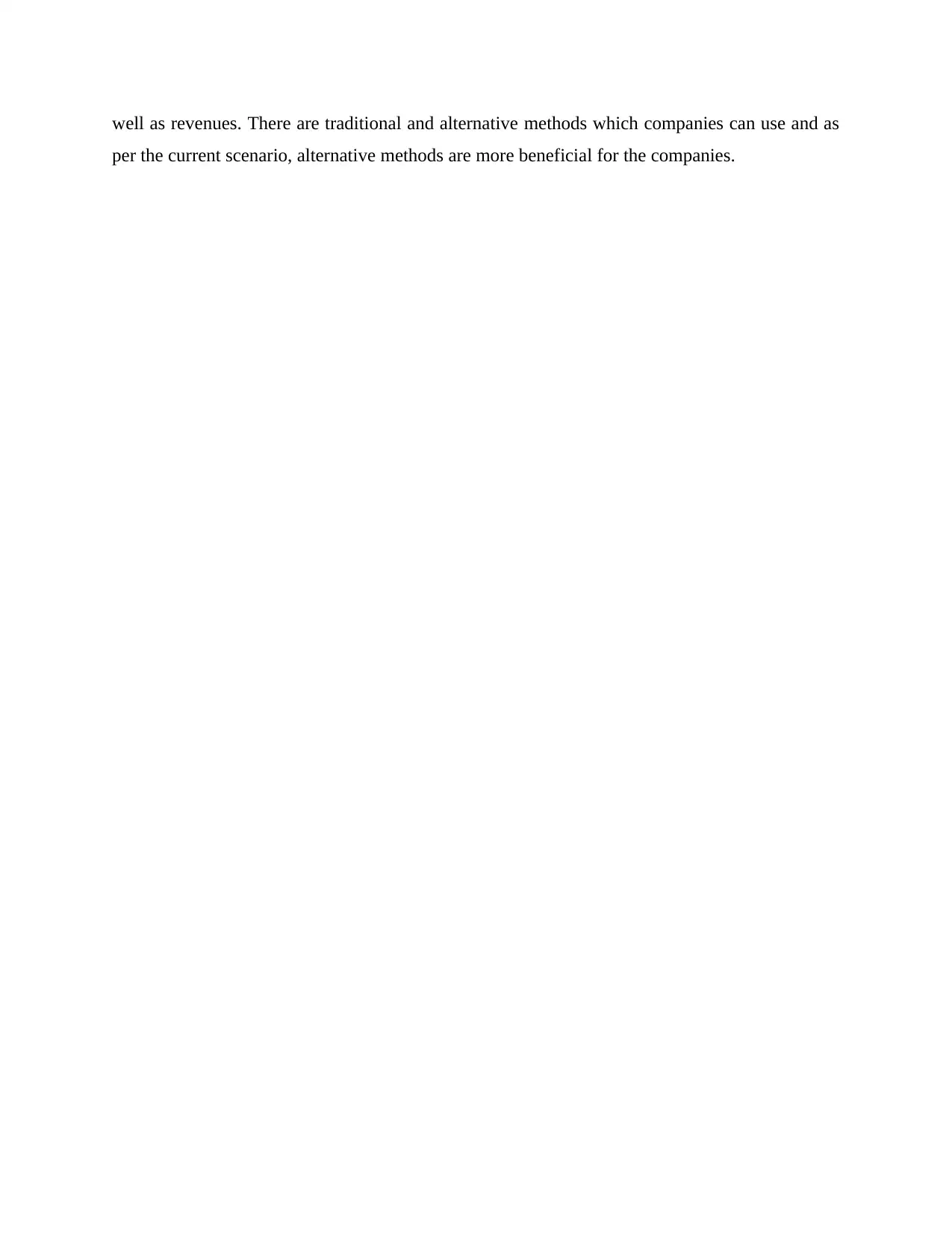
well as revenues. There are traditional and alternative methods which companies can use and as
per the current scenario, alternative methods are more beneficial for the companies.
per the current scenario, alternative methods are more beneficial for the companies.
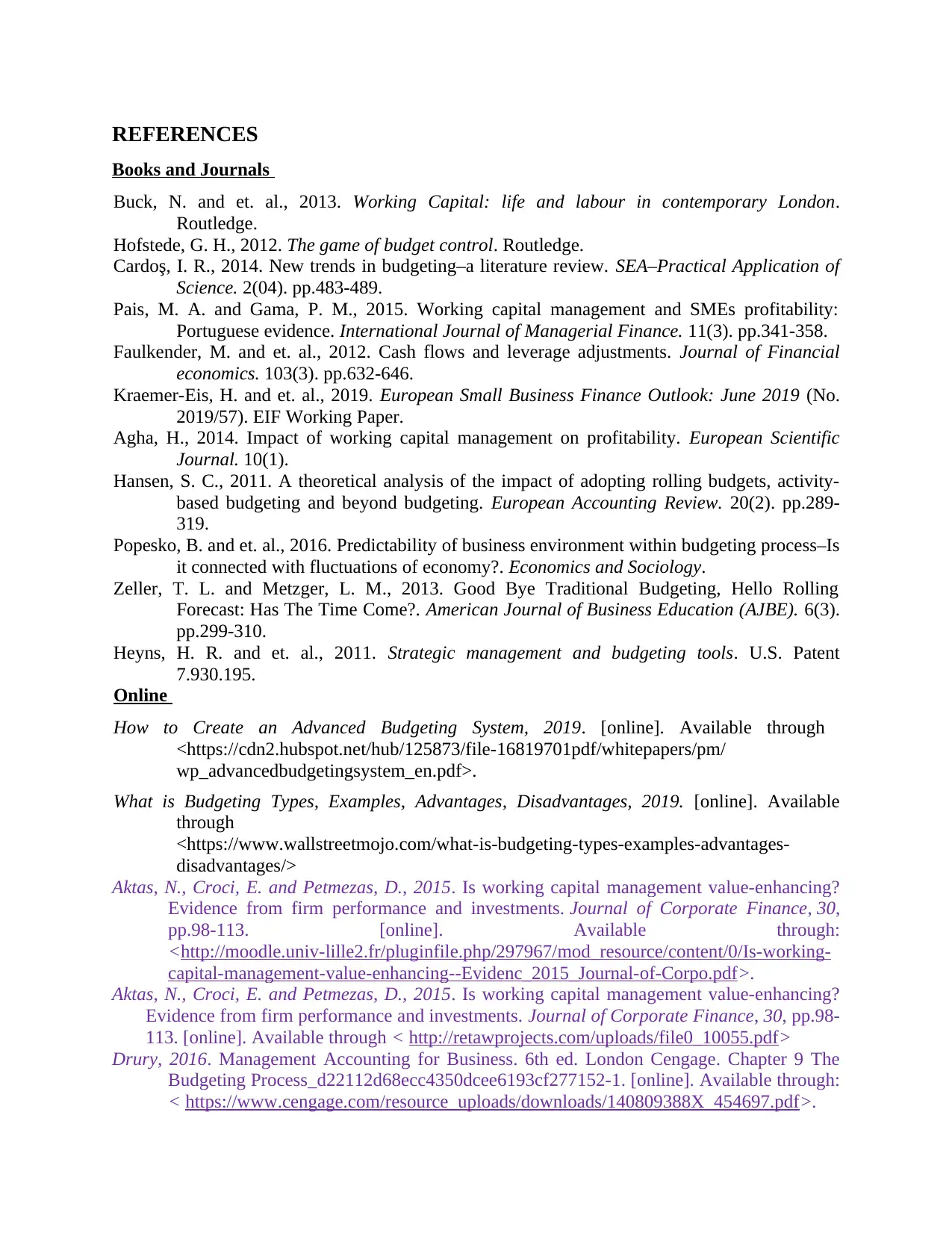
REFERENCES
Books and Journals
Buck, N. and et. al., 2013. Working Capital: life and labour in contemporary London.
Routledge.
Hofstede, G. H., 2012. The game of budget control. Routledge.
Cardoş, I. R., 2014. New trends in budgeting–a literature review. SEA–Practical Application of
Science. 2(04). pp.483-489.
Pais, M. A. and Gama, P. M., 2015. Working capital management and SMEs profitability:
Portuguese evidence. International Journal of Managerial Finance. 11(3). pp.341-358.
Faulkender, M. and et. al., 2012. Cash flows and leverage adjustments. Journal of Financial
economics. 103(3). pp.632-646.
Kraemer-Eis, H. and et. al., 2019. European Small Business Finance Outlook: June 2019 (No.
2019/57). EIF Working Paper.
Agha, H., 2014. Impact of working capital management on profitability. European Scientific
Journal. 10(1).
Hansen, S. C., 2011. A theoretical analysis of the impact of adopting rolling budgets, activity-
based budgeting and beyond budgeting. European Accounting Review. 20(2). pp.289-
319.
Popesko, B. and et. al., 2016. Predictability of business environment within budgeting process–Is
it connected with fluctuations of economy?. Economics and Sociology.
Zeller, T. L. and Metzger, L. M., 2013. Good Bye Traditional Budgeting, Hello Rolling
Forecast: Has The Time Come?. American Journal of Business Education (AJBE). 6(3).
pp.299-310.
Heyns, H. R. and et. al., 2011. Strategic management and budgeting tools. U.S. Patent
7.930.195.
Online
How to Create an Advanced Budgeting System, 2019. [online]. Available through
<https://cdn2.hubspot.net/hub/125873/file-16819701pdf/whitepapers/pm/
wp_advancedbudgetingsystem_en.pdf>.
What is Budgeting Types, Examples, Advantages, Disadvantages, 2019. [online]. Available
through
<https://www.wallstreetmojo.com/what-is-budgeting-types-examples-advantages-
disadvantages/>
Aktas, N., Croci, E. and Petmezas, D., 2015. Is working capital management value-enhancing?
Evidence from firm performance and investments. Journal of Corporate Finance, 30,
pp.98-113. [online]. Available through:
<http://moodle.univ-lille2.fr/pluginfile.php/297967/mod_resource/content/0/Is-working-
capital-management-value-enhancing--Evidenc_2015_Journal-of-Corpo.pdf>.
Aktas, N., Croci, E. and Petmezas, D., 2015. Is working capital management value-enhancing?
Evidence from firm performance and investments. Journal of Corporate Finance, 30, pp.98-
113. [online]. Available through < http://retawprojects.com/uploads/file0_10055.pdf>
Drury, 2016. Management Accounting for Business. 6th ed. London Cengage. Chapter 9 The
Budgeting Process_d22112d68ecc4350dcee6193cf277152-1. [online]. Available through:
< https://www.cengage.com/resource_uploads/downloads/140809388X_454697.pdf>.
Books and Journals
Buck, N. and et. al., 2013. Working Capital: life and labour in contemporary London.
Routledge.
Hofstede, G. H., 2012. The game of budget control. Routledge.
Cardoş, I. R., 2014. New trends in budgeting–a literature review. SEA–Practical Application of
Science. 2(04). pp.483-489.
Pais, M. A. and Gama, P. M., 2015. Working capital management and SMEs profitability:
Portuguese evidence. International Journal of Managerial Finance. 11(3). pp.341-358.
Faulkender, M. and et. al., 2012. Cash flows and leverage adjustments. Journal of Financial
economics. 103(3). pp.632-646.
Kraemer-Eis, H. and et. al., 2019. European Small Business Finance Outlook: June 2019 (No.
2019/57). EIF Working Paper.
Agha, H., 2014. Impact of working capital management on profitability. European Scientific
Journal. 10(1).
Hansen, S. C., 2011. A theoretical analysis of the impact of adopting rolling budgets, activity-
based budgeting and beyond budgeting. European Accounting Review. 20(2). pp.289-
319.
Popesko, B. and et. al., 2016. Predictability of business environment within budgeting process–Is
it connected with fluctuations of economy?. Economics and Sociology.
Zeller, T. L. and Metzger, L. M., 2013. Good Bye Traditional Budgeting, Hello Rolling
Forecast: Has The Time Come?. American Journal of Business Education (AJBE). 6(3).
pp.299-310.
Heyns, H. R. and et. al., 2011. Strategic management and budgeting tools. U.S. Patent
7.930.195.
Online
How to Create an Advanced Budgeting System, 2019. [online]. Available through
<https://cdn2.hubspot.net/hub/125873/file-16819701pdf/whitepapers/pm/
wp_advancedbudgetingsystem_en.pdf>.
What is Budgeting Types, Examples, Advantages, Disadvantages, 2019. [online]. Available
through
<https://www.wallstreetmojo.com/what-is-budgeting-types-examples-advantages-
disadvantages/>
Aktas, N., Croci, E. and Petmezas, D., 2015. Is working capital management value-enhancing?
Evidence from firm performance and investments. Journal of Corporate Finance, 30,
pp.98-113. [online]. Available through:
<http://moodle.univ-lille2.fr/pluginfile.php/297967/mod_resource/content/0/Is-working-
capital-management-value-enhancing--Evidenc_2015_Journal-of-Corpo.pdf>.
Aktas, N., Croci, E. and Petmezas, D., 2015. Is working capital management value-enhancing?
Evidence from firm performance and investments. Journal of Corporate Finance, 30, pp.98-
113. [online]. Available through < http://retawprojects.com/uploads/file0_10055.pdf>
Drury, 2016. Management Accounting for Business. 6th ed. London Cengage. Chapter 9 The
Budgeting Process_d22112d68ecc4350dcee6193cf277152-1. [online]. Available through:
< https://www.cengage.com/resource_uploads/downloads/140809388X_454697.pdf>.
⊘ This is a preview!⊘
Do you want full access?
Subscribe today to unlock all pages.

Trusted by 1+ million students worldwide
1 out of 13
Related Documents
Your All-in-One AI-Powered Toolkit for Academic Success.
+13062052269
info@desklib.com
Available 24*7 on WhatsApp / Email
![[object Object]](/_next/static/media/star-bottom.7253800d.svg)
Unlock your academic potential
Copyright © 2020–2025 A2Z Services. All Rights Reserved. Developed and managed by ZUCOL.





